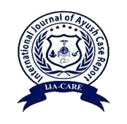Grade- III Adenoid Hypertrophy treated with Individualized Homoeopathy – a Case Report
Abstract
Adenoid is lymphoid tissue located at the portal of the upper respiratory tract. Snoring, mouth breathing, and recurrent upper respiratory tract infections, are the common presentations of Adenoid hypertrophy in children. Adenoids regress after 15 years of age. A case of Adenoid hypertrophy [AH], in a 3-year-old male child treated in the outpatient department of the National Homoeopathy Research Institute in Mental Health, is presented here, with an interim review at 11 months. Before and after values for the Clinical rating score, Mallampati score, Tonsillar score, and Adenotonsillar ratio [A/N] were calculated. The case reporting was done according to HOM-CASE guidelines. Homoeopathic medicines Tuberculinum Bovinum Kent (Tub-b)200c for the first five months, followed by Calcarea Carbonica (Calc-c)200c for the next three months and Mercurius Solubilis (Merc-sol) 200c for the last three months reduced the clinical rating score from 9 to 6, Tonsillar score from 3 to 2, and A/N ratio from 0.82 to 0.66. MONARCH scores for Tub-b, Calc-c, and Merc-sol were +6/13, +2/13, and +9/13, respectively. There was a clinically relevant improvement for the obstructive symptoms and the radiological findings before and after individualized homoeopathy.

This work is licensed under a Creative Commons Attribution-NonCommercial-NoDerivatives 4.0 International License.

